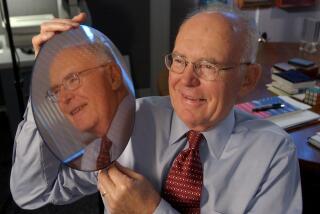A Blurry View of Xerox’s Rise
- Share via
Joe Wilson joined the family firm, a small photographic paper company based in Rochester, N.Y., during the early years of the Depression and oversaw its transformation into the mighty Xerox Corp.
It was one of the most spectacular industrial accomplishments of the 20th century. One might therefore expect to find him in the pantheon of U.S. business greats. Today, though, he is all but forgotten.
“By the end of the century, students at the University of Rochester’s business school would not, when asked, even recognize the name Joe Wilson,” Charles Ellis writes in his messy, lugubrious book “Joe Wilson and the Creation of Xerox.”
Even during Wilson’s tenure, the late Xerox Chairman and General Counsel Sol Linowitz, his “best friend,” was able to use his communication skills to convince the New York Times and Life magazine that he, Linowitz, actually ran the company and was rewarded with substantial personal coverage.
The intensely ambitious Linowitz eventually left Xerox for Washington, where he achieved distinction as a diplomat during the Jimmy Carter presidency.
The self-effacing Wilson, who died in 1971 of a heart attack, remains an enigma that Charles Ellis does little to unravel.
The book is hagiography, pure and simple. For page after page, Wilson is painted as a latter-day saint among businessmen.
He is concerned for his workers’ welfare. He values his customers. He worries about the position of women and minorities in the workforce. He speed-reads, holds the company’s financial records in his head and comes out on top when senior Xerox executives take personality and leadership tests. Unlike Linowitz, he also spreads around the credit for Xerox’s success.
Now, there is nothing wrong with any of this. Would that we had more business leaders with these qualities.
But this is a man who led by example, listened to criticism and advice, was cautious and logical in his business dealings, yet handpicked a successor who seemingly had none of these attributes.
Peter McColough, who took over from Wilson in 1968, plunged Xerox into a number of ill-judged acquisitions and other adventures that cost the company billions of dollars as well as its reputation for sound management. It has taken years to recover.
The Xerox story is, nevertheless, a classic of entrepreneurship and technology. Chester Carlson, a physicist and lawyer, became fascinated by the problem of creating copies of documents quickly and cleanly, in contrast to the time-consuming “wet” photographic methods of the time.
He invented “electrophotography” -- later known as xerography -- in which the image of the material to be copied was traced out in an electrostatic pattern to which oppositely charged toner particles were attracted and fused by heat.
It was an invention of such sheer originality that no large company could be persuaded to invest in the hugely expensive business of bringing xerography to market. At last, the Battelle Memorial Institute, a research organization, agreed to invest in the technology.
Ellis quotes Battelle’s Harold E. Clark: “I’m as amazed by his discovery now as when I first heard of it. As an invention it was magnificent. The only trouble was that as a product it wasn’t any good.”
The chance paved the way for the entry of Wilson. By now head of Haloid, the family firm, he was looking for a new technology to save it from slow death as the photographic paper business crumbled.
Terms were agreed upon in 1947, and the two organizations began work on the machine that 13 years later would reach the market as the Xerox 914, one of the most successful products of all time and the springboard for Xerox’s rapid growth.
In 1960, net income was $2.6 million. By 1963, it was $22.6 million.
With hindsight, it is clear that had the participants understood the nature of the technological and financial challenges facing them as they tried to bring the 914 to market, they would have given up immediately.
As it was, the conviction of Wilson and Carlson that they were nurturing a winner was enough to see the project through to completion.
For all its excellent qualities, Wilson’s character does not seem strong or interesting enough to sustain a book of more than 350 pages.
The challenges the Haloid team faced in creating the 914 would have made fascinating -- and not too technical -- reading, but Ellis sidesteps most of this.
Ellis’ technique of dealing with discrete topics in separate chapters also undermines any sense of continuity as the nascent Xerox matures. Wilson and Xerox deserve a great biography. But this is not it.
Alan Cane is a writer for the Financial Times, in which this review first appeared.
*
Man and machine
Joe Wilson and the Creation of Xerox
* By Charles D. Ellis
* John Wiley & Sons Inc., $27.95, 416 pages
Source: Publisher
Los Angeles Times
More to Read
Inside the business of entertainment
The Wide Shot brings you news, analysis and insights on everything from streaming wars to production — and what it all means for the future.
You may occasionally receive promotional content from the Los Angeles Times.










